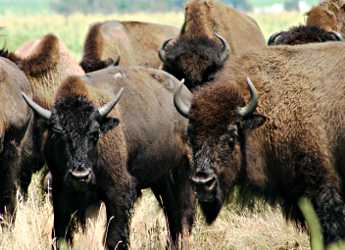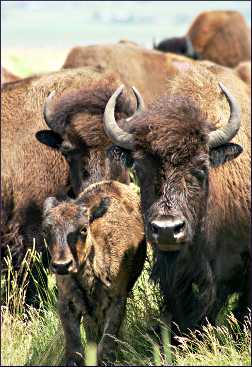Eyeballing bison
Once creatures of Old West yore, the national mammal can be seen in a park or preserve near you.

© Beth Gauper
Like bald eagles, bison have staged a spectacular comeback.
Now, the massive creatures that once roamed the plains by the millions has joined the national bird as the national mammal.
Herds have grown, including the genetically pure herd at Wind Cave National Park in South Dakota, and have shared bison with parks and preserves in Minnesota, Illinois, Iowa and Wisconsin.
Now anyone can see bison, or buffalo, often on tallgrass prairie restored to its original state.
When to go? In April and May, calves are born. In late July and August, bulls go into rut, showing dominance by fighting, bellowing and wallowing in dust.
Bison also can be seen on farms, where they sometimes cause trouble. Unlike cows, they're powerful, unpredictable and fast — they can gallop at up to 35 mph and turn on a dime. And with bulls weighing 2,000 pounds, they can barrel through a fence if they really want to.
Never get close to bison, who have poor eyesight but excellent hearing and sense of smell. Every year, several tourists are gored by bison in Yellowstone National Park. If you see a bison with an upraised tail, you're in trouble.
But bison mind their own business, if you mind yours.
You can see bison at these parks and preserves. Bring binoculars in case the herd isn't close to a fence or road.
Up close, you can watch for prairie wildflowers, including shooting stars, pussytoes and prairie smoke in spring and lead plant, Queen Anne's lace and purple prairie clover in summer.
Minnesota: On the Prairie Coteau in the state's southwest corner, Blue Mounds State Park has a herd of about 100 that can be seen from the fence or an observation platform. The park also offers a 90-minute bus tour to observe them and enjoy the prairie landscape.
For more about Blue Mounds State Park, see Drama on the Prairie Coteau.

© Beth Gauper
Near Mankato, Minneopa State Park has a herd of more than 20 bison that can be seen from vehicles. The drive around the bison enclosure is open daily except Wednesday.
In Afton, just half an hour east of the Twin Cities, there's a herd at Belwin Conservancy, with an observation platform. It's open whenever bison are present, generally June through October.
Illinois: Two preserves, not far from Chicago, have herds of bison.
Just east of Dixon on the Rock River, the Nature Conservancy owns Nachusa Grasslands, which has a herd of more than 100. They can be seen from roadsides.
Volunteers give two-hour tours from May through October. Sign-ups are posted at 7 a.m. the first day of each month, and places fill quickly.
There's another growing herd of bison in Midewin National Tallgrass Prairie, south of Joliet. They can be seen by hiking or biking to the fence line. There's a Welcome Center, and families can borrow a "bison box" of educational materials.
Weather permitting, a ranger leads a walk to look for bison each Sunday from May through October.
Iowa: In the northern part of the Loess Hills region of western Iowa, there's a herd of more than 200 bison at Broken Kettle Grasslands preserve, Iowa's largest remaining prairie.
They can be seen from viewing points along the road or from hiking trails.
Wisconsin: There's a herd of about 15 bison at Sandhill Wildlife Area, 15 miles west of Wisconsin Rapids. They can be seen from the Bison Barrens observation tower, off the Trumpeter Trail auto tour.
More about bison: Here are 15 interesting facts.